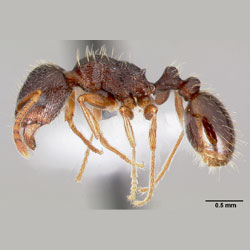The pavement ant workers are about 2.5–4 mm long and vary in color from dark brown to black, with parallel furrows or lines on the head and thorax. The pedicel, which connects the thorax and abdomen, has two segments. The posterior/dorsal thorax has two spines that project upward to the rear, and they carry a stinger in the last abdominal segment. The swarmers or reproductive ants are winged, about twice the size of the workers, and also have a furrowed head and thorax. The spines are evident on the females but absent on the males.
Most colonies are located under sidewalks, building slabs, and large rocks. Ants enter buildings through cracks in foundation walls and interior slabs. It is common to see sand piles and small soil particles in structures near cracks in concrete slabs or at the top of foundation walls where the ants deposit debris from excavated nests. Similar piles are seen in the warmer months at the cracks in sidewalks.
Pavement ants feed on a wide variety of food. Sweets, including sugar, nectar, fruits, and syrups are readily taken. Grease, dead insects, and small seeds also are collected and stored in the nest. Nearly any morsel of food that falls to the floor will be consumed.
Prevention Tips
Although you may observe these ants trailing during the day, most observation will occur at night.
Pavement Ants will displace soil around concrete objects such as sidewalks, patios, driveways, curbs, etc. This displaced loose soil may be seen along the cracks or joints in the sidewalks or driveways.
Look for colonies around the foundations of your home. Also inspect around logs or large rocks.
Inside, look around baseboards, plumbing, sinks, toilets, and along the edges of carpets.

